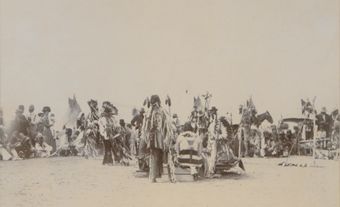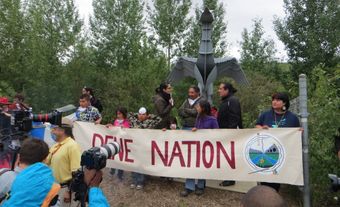Who are the Piikani?
Their name is an adaptation of the word apiku'ni, meaning “badly tanned robe.” They were known to fur traders as the Muddy River Indians. The official spelling of their name in Canada is Piikani (also spelled Piikuni); in the United States it is Piegan (although modern-day Piegan in the US have adopted the title of Blackfeet Indians of Montana). Due to a historical, geographic division between the bands living in Canada and the US, the Piikani are also known as Aapátohsipikáni or “Northern Piikani,” while the Piegan are referred to as Aamsskáápipikani or “Southern Piikani.”
Population and Territory
The Piikani’s vast hunting ground once ranged from along the foothills from Rocky Mountain House to Heart Butte, Montana, and eastward onto the Plains. The Piikani also travelled north and east in present-day Alberta to hunt. By the mid-1800s, they had moved south to an area around the Milk River in Alberta and the Teton and Marias rivers in Montana. (See alsoPlains Indigenous Peoples in Canada and Indigenous Territory.)
Today, the Piikani have two reserves in Alberta, one of which is a timber reserve, the other is the location of the town site. According to thefederal government, there are 3,884 registered members living and working both on and off reserve. In the 2016 census, 22,490 people identified as having Blackfoot ancestry. This number includes the Piikani as well as the Siksika and Kainai.
Pre-contact Life
In the pre-colonial era, the Piikani, like other Blackfoot nations, were dependent on the bison or buffalo (Iinii) for food, clothing and to make tools. While they also hunted other large game, such as deer, and supplemented their diet with vegetables, nuts and fruits, their traditional economy and culture centred on the bison hunt.
The Piikani had complex warrior societies. Their enemies included the Crow, Shoshone, Nez Percé, Dakota and Assiniboine. Warfare among Indigenous nations during the 1700s intensified with the introduction of guns and horses by Europeans. Warriors held a high social status in their communities as defenders of the Blackfoot nations.
Society and Culture
Historically, the Piikani were a large community, numbering about 3,000 to 5,000 before colonization. Although it is not clear why, the Piikani divided into northern and southern bands prior to the arrival of European traders. Despite this separation, they often travelled together and were so intermingled that a clear division was impossible.
Piikani culture was traditionally passed on through oral histories. This culture includes participating in sweat lodges, the Sun Dance, using medicine bundles, and other means of purifying the body and soul. While various government-implemented assimilation policies, such as the Indian Act and residential schools, threatened and even outlawed the practicing of certain cultural ceremonies, Piikani culture has survived to this day.
Language
Belonging to the Algonquian linguistic family, the Piikani speak the same language as the Kainai and Siksika, with only slight dialectal variations. In the 2016 census, 5,565 people identified as a speaker of a Blackfoot language, with 98.7 per cent living in Alberta. However, this number does not identify the fluency level of the speakers. Considered an endangered language, schools and language programs seek to preserve and promote the Kainai language. (See also Indigenous Languages in Canada.)
Religion and Spirituality

The Piikani had a strong religious and spiritual culture that was passed on through oral histories. This culture includes participating in sweat lodges, the Sun Dance, using medicine bundles, and other means of purifying the body and soul.
In the pre-contact era, the Piikani maintained a system of religious beliefs and practiced culturally-specific spiritual ceremonies. The Sun Dance was (and still is) one of the most important cultural and spiritual practices. While the arrival of Christian missionaries in the 1870s introduced significant changes to Piikani spirituality and lifestyle, oral histories keep many of the traditional beliefs alive today. (See also Religion and Spirituality of Indigenous Peoples in Canada.)
Creation Stories
Although creation stories differ according to northern and southern oral traditions, the Piikani and Piegan generally believe that the Creator (also known as Old Man or N’api) was light personified, and considered to be the beginning of the day, the beginning of life. In some Piikani stories, Old Man is associated with the sun and therefore referred to as Natos (sun). As in other Indigenous religions, the Creator is non-human and non-gendered. Old Man created and is eternally part of all the living people, creatures and life forms on the earth.
Contact with Europeans
During the 1700s, the Piikani interacted with traders from the United States and the Hudson’s Bay Company. Supported by a large Blackfoot force, the Piikani and their allies were one of the most powerful Indigenous groups on the Northern Plains, temporarily impeding the westward expansion of European settlers.
However, contact with White traders and missionaries had significant effects on Piikani traditional life. Exposure to European diseases and intensified warfare reduced their population after the 1837 smallpox epidemic. In 1870, seven years before the northern and southern groups settled on reserves, their population was further reduced.
Treaties
After signing a treaty with the Americans in 1855, the Blackfoot Confederacy received an initially vast reserve in present-day Montana from the United States government. This reserve was reduced after the American government used military force to pressure the Blackfoot Confederacy to surrender more land for settlers. About 220 Piegans died in 1870 as a result of the conflict. While most Piegans settled on the reduced Montana reserve, some joined the northern group in Canada, where they signed Treaty 7 with the federal government in 1877. (See also Numbered Treaties.)
The Piikani asked for their home base to be their wintering areas, where they hunted bison, around the Crow Creeks, Oldman River and Porcupine Hills. However, the disappearance of the bison in the late 1800s made life on the reserve that much more difficult. Historians commonly refer to the winter of 1883–84 as the “starvation winter” because of the widespread hunger that plagued the confederacy that season. The end of the bison hunt encouraged the Piikani to move to the area around Pincher Creek and to practice ranching, which is still a successful part of their economy. (See also Ranching History.)
Contemporary Life
As of 2016, the Piikani Nation counts about 3,600 registered members, nearly 40 per cent of whom live and/or work and go to school in urban areas off reserve. The Piikani have two reserves in southern Alberta with a total landmass of 45,677.8 ha. Reserve 147a (located along Highway 3, midway between Fort Macleod and Pincher Creek) is known as the Brocket town site, and Reserve 147b (13 km southwest of Fort Macleod) is known as the Timber Reserve. The Piikani engage in ranching, agriculture and other business ventures on reserve. They are also an active member in Indigenous associations, including the Treaty 7 Management Corporation and Blackfoot Confederacy.
In 2014, the Piikani joined other First Nations in signing the Iinii Treaty or Buffalo Treaty, including: the Blackfeet Nation, Siksika Nation, Kainai Nation, Assiniboine and Gros Ventre Tribes of Fort Belknap Reservation, Assiniboine and Dakota (Sioux) Tribes of Fort Peck Reservation, Confederated Salish and Kootenai Tribes (see also Coast and Interior Salish), and the Tsuut’ina Nation. In 2015, the Stoney Nakoda Nation and the Samson Cree Nation also signed this “open treaty,” which is open to other First Nations from Canada and the US. Among other issues, the signatories agreed to unite the political power of Northern Plains Indigenous nations, work towards bison conservation and strengthen traditional relationships to the land.

 Share on Facebook
Share on Facebook Share on X
Share on X Share by Email
Share by Email Share on Google Classroom
Share on Google Classroom










